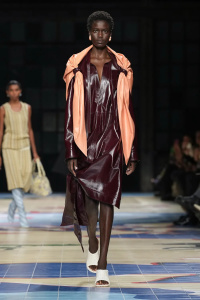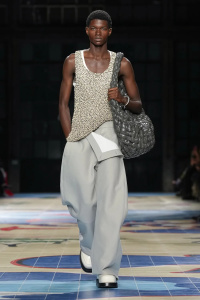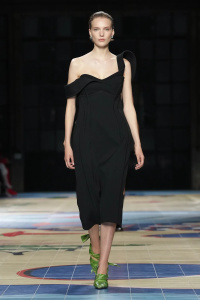[Blazy] took elements of regional dress from all over the world and blended them together. Only a trace of the original style remained, and even then one couldn’t be sure if the thick fringe on the hem of a full herringbone-patterned skirt evoked tango in Argentina or the fringed yoke of a fitted red-leather top with a peplum over a red-leather sarong referenced the Maasai, or a white peacoat with partially undone flap-front trousers was a positively a merchant sailor. So Blazy was both voyager and collector.
I found it funny that he gave some of his characters — and that is what they were — a folded-leather clutch or a crumpled sack resembling a newspaper in texture and printing. Does anybody read a newspaper nowadays when they travel? You can rarely find one in a hotel.
In many ways, this complicated collection wasn’t about the experience of travel but rather, about the instant access to places that the internet provides.
A lot of garments were so bulky and cumbersome looking — dresses with giant barnacles of fringe, heavy leather coats with beefy shoulders or extraneous flaps, a red-leather dress with wide sleeves
and an overskirt in leather —
that they would need their own large suitcase.
Weirdly, the collection threw down its own obstacles to pleasure. The texture and pattern of some of Blazy’s men’s pullovers were remarkable; one, in bands of black, gray, and off-white, had red zig-zags disrupting the stripes, like a jumpy S&P 500 chart.
But only in certain climate conditions could you possibly wear such a thick sweater. Again, the scale and complexity of the garments imply that they are only for those with the means to wear and transport them comfortably, the ultrarich. Or an influencer on Instagram. Which pretty much deflates the true democrat sentiment offered in Blazy’s show notes, of adventure with “a spring in every step,” a line borrowed from, of all people, Mark Twain.
Like newspapers, this kind of travel — indeed elaborate clothes — is becoming obsolete.
Of course, craft and creativity have value, and we’ve seen some outstanding examples of both during the Milan shows, notably at
Prada and at
Gucci, chiefly with craft.
But at Bottega Veneta, it’s hard to see how these essential things are helping Blazy develop a clear aesthetic for the brand. With Prada, for example, you see — nearly every season — a universe you know and are intrigued to enter. With Bottega, though, you get disconnected islands and a voyager who naively refuses to turn towards home.




